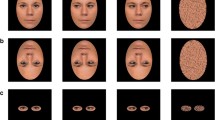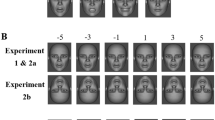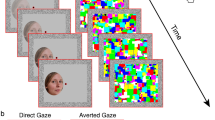Abstract
While viewing faces, humans often demonstrate a natural gaze bias towards the left visual field, that is, the right side of the viewee’s face is often inspected first and for longer periods. Previous studies have suggested that this gaze asymmetry is a part of the gaze pattern associated with face exploration, but its relation with perceptual processing of facial cues is unclear. In this study we recorded participants’ saccadic eye movements while exploring face images under different task instructions (free viewing, judging familiarity and judging facial expression). We observed a consistent left gaze bias in face viewing irrespective of task demands. The probability of the first fixation and the proportion of overall fixations directed at the left hemiface were indistinguishable across different task instructions or across different facial expressions. It seems that the left gaze bias is an automatic reflection of hemispheric lateralisation in face processing, and is not necessarily correlated with the perceptual processing of a specific type of facial information.




Similar content being viewed by others
References
Barton, J. J. S., Radcliffe, N., Cherkasova, M. V., Edelman, J., & Intriligator, J. M. (2006). Information processing during face recognition: the effects of familiarity, inversion, and morphing on scanning fixations. Perception, 35, 1089–1105.
Borod, J. C., Haywood, C. S., & Koff, E. (1997). Neuropsychological aspects of facial asymmetry during emotional expression: a review of the normal adult literature. Neuropsychology Review, 7, 41–60.
Brady, N., Campbell, M., & Flaherty, M. (2005). Perceptual asymmetries are preserved in memory for highly familiar faces of self and friend. Brain and Cognition, 58, 334–342.
Bruce, V., & Young, A. (1986). Understanding face recognition. British Journal of Psychology, 77, 305–327.
Burt, D. M., & Perrett, D. I. (1997). Perceptual asymmetries in judgements of facial attractiveness, age, gender, speech and expression. Neuropsychologia, 35, 685–693.
Butler, S., Gilchrist, I. D., Burt, D. M., Perrett, D. I., Jones, E., & Harvey, M. (2005). Are the perceptual biases found in chimeric face processing reflected in eye-movement patterns? Neuropsychologia, 43, 52–59.
Coolican, J., Eskes, G. A., McMullen, P. A., & Lecky, E. (2008). Perceptual biases in processing facial identity and emotion. Brain and Cognition, 66, 176–187.
Dahl, C. D., Wallraven, C., Bulthoff, H. H., & Logothetis, N. K. (2009). Humans and macaques employ similar face-processing strategies. Current Biology, 19, 509–513.
De Renzi, E., Perani, D., Carlesimo, G. A., Silveri, M. C., & Fazio, F. (1994). Prosopagnosia can be associated with damage confined to the right hemisphere—an MRI and PET study and a review of the literature. Neuropsychologia, 8, 893–902.
Gauthier, I., Tarr, M. J., Moylan, J., Skudlarski, P., Gore, J. C., & Anderson, A. W. (2000). The fusiform “face area” is part of a network that processes faces at the individual level. Journal of Cognitive Neuroscience, 12, 495–504.
Gilbert, C., & Bakan, P. (1973). Visual asymmetry in perception of faces. Neuropsychologia, 11, 355–362.
Gobbini, M. I., & Haxby, J. V. (2007). Neural systems for recognition of familiar faces. Neuropsychologia, 45, 32–41.
Guo, K., Mahmoodi, S., Robertson, R. G., & Young, M. P. (2006). Longer fixation duration while viewing face images. Experimental Brain Research, 171, 91–98.
Guo, K., Meints, K., Hall, C., Hall, S., & Mills, D. (2009). Left gaze bias in humans, rhesus monkeys and domestic dogs. Animal Cognition, 12, 409–418.
Guo, K., Tunnicliffe, D., & Roebuck, H. (2010). Human spontaneous gaze patterns in viewing of faces of different species. Perception, 39, 533–542.
Haxby, J. V., Hoffman, E. A., & Gobbini, M. I. (2000). The distributed human neural system for face perception. Trends in Cognitive Science, 4, 223–233.
Heath, R. L., Rouhana, A., & Ghanem, D. A. (2005). Asymmetric bias in perception of facial affect among Roman and Arabic script readers. Laterality, 10, 51–64.
Indersmitten, T., & Gur, R. C. (2003). Emotion processing in chimeric faces: hemispheric asymmetries in expression and recognition of emotions. Journal of Neuroscience, 23, 3820–3825.
Jewell, G., & McCourt, M. E. (2000). Pseudoneglect: a review and meta-analysis of performance factors in line bisection tasks. Neuropsychologia, 38, 93–110.
Kanwisher, N., McDermott, J., & Chun, M. M. (1997). The fusiform face area: a module in human extrastriate cortex specialized for face perception. Journal of Neuroscience, 17, 4302–4311.
Kirouac, G., & Doré, F. Y. (1984). Judgment of facial expressions of emotion as a function of exposure time. Perceptual and Motor Skills, 59, 147–150.
Leonards, U., & Scott-Samuel, N. E. (2005). Idiosyncratic initiation of saccadic face exploration in humans. Vision Research, 45, 2677–2684.
Luh, K. E., Rueckert, L. M., & Levy, J. (1991). Perceptual asymmetries for free viewing of several types of chimeric stimuli. Brain and Cognition, 16, 83–103.
Malcolm, G. L., Lanyon, L. J., Fugard, A. J. B., & Barton, J. J. S. (2008). Scan patterns during the processing of facial expression versus identity: An exploration of task-driven and stimulus-driven effects. Journal of Vision, 8(8):2, 1–9.
Martinez, A. M., & Benavente, R. (1998). The AR Face Database. CVC Technical Report #24, June 1998.
Mattingley, J. B., Bradshaw, J. L., Phillips, J. G., & Bradshaw, J. A. (1993). Reversed perceptual asymmetry for faces in left unilateral neglect. Brain and Cognition, 23, 145–165.
Mertens, I., Siegmund, H., & Grusser, O. J. (1993). Gaze motor asymmetries in the perception of faces during a memory task. Neuropsychologia, 31, 989–998.
Murphy, F. C., Nimmo-Smith, I., & Lawrence, A. D. (2003). Functional neuroanatomy of emotions: a meta-analysis. Cognitive, Affective, & Behavioral Neuroscience, 3, 207–233.
Nicholls, M. E. R., & Roberts, G. R. (2002). Can free-viewing perceptual asymmetries be explained by scanning, pre-motor or attentional biases? Cortex, 38, 113–136.
Niemeier, M., Stojanoski, B., & Greco, A. (2007). Influence of time and spatial frequency on the perceptual bias: evidence for competition between hemispheres. Neuropsychologia, 45, 1029–1040.
Philips, M. L., & David, A. S. (1997). Viewing strategies for simple and chimeric faces: An investigation of perceptual bias in normal and schizophrenic patients using visual scan paths. Brain and Cognition, 32, 225–238.
Rhodes, G. (1986). Perceptual asymmetries in face recognition. Brain and Cognition, 4, 197–218.
Schyns, P. G., Bonnar, L., & Gosselin, F. (2002). Show me the features! Understanding recognition from the use of visual information. Psychological Science, 13, 402–409.
Vaid, J., & Singh, M. (1989). Asymmetries in the perception of facial affect: Is there an influence of reading habits? Neuropsychologia, 27, 1277–1287.
van Belle, G., Ramon, M., Lefèvre, P., & Rossion, B. (2010). Fixation patterns during recognition of personally familiar and unfamiliar faces. Frontiers in Psychology, 1, 20.
Vinette, C., Gosselin, F., & Schyns, P. G. (2004). Spatio-temporal dynamics of face recognition in a flash: it’s in the eyes. Cognitive Science, 28, 289–301.
Willis, J., & Todorov, A. (2006). First impressions: making up your mind after a 100-ms exposure to a face. Psychological Science, 17, 592–598.
Author information
Authors and Affiliations
Corresponding author
Rights and permissions
About this article
Cite this article
Guo, K., Smith, C., Powell, K. et al. Consistent left gaze bias in processing different facial cues. Psychological Research 76, 263–269 (2012). https://doi.org/10.1007/s00426-011-0340-9
Received:
Accepted:
Published:
Issue Date:
DOI: https://doi.org/10.1007/s00426-011-0340-9




